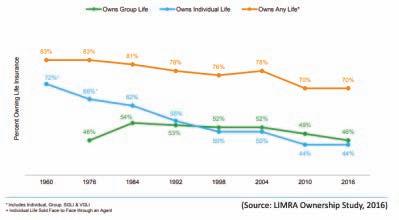
3 minute read
Trends in Life Insurance Ownership

As ownership rates decline, you need to connect your passion as an agent with the trends that are driving consumer behavior.
By James W. Kerley, LLIF
LIMRA research shows that 50 million American households need life insurance. As a financial professional, are you helping more people get the coverage they need? Are you putting life insurance first in your practice? Recently, I asked the CEO of a leading life insurance company these same questions. “My passion and deep belief is that people in the U.S. are not insured and my goal is to change that for our company and the industry,” she said. “It is a thrill convincing our associates and advisors to believe in life insurance first. What drives me every day is turning around the policyholder count and supporting advisors who have the same goal.” With plenty of experienced and long-tenured advisors offering life insurance solutions to their older clients, it is not surprising that over the last few years, total life insurance premium has continued to grow. However, as an industry, do we want our measure of success simply to be premium growth? In the world of customer engagement, many would say that ownership levels and life insurance policyholder counts are measures that are more important.
Ownership rates
So how are we doing? As it turns out, not all that well. Since 1960, the ownership rate has dropped from a high of 83 percent to just 70 percent of American households in 2016. Seventy-two percent of U.S. households owned individual life insurance in 1960, and according to the 2016 LIMRA Life Ownership study, only 44 percent of Americans owned individual life insurance in 2016.
Why the large percentage decline in ownership? Competing financial priorities, less fear of dying due to advances in medicine and higher mortality rates, and the increase in the number of dual-income families may account for some of the reasons consumers do not feel as compelled to own life insurance as they once did.
But one of the most important reasons people aren’t buying life insurance may be that they haven’t been contacted by an agent or advisor to help them. The truth is that in the age of online shopping with mobile and smartphone technology, consumers of all ages still want the advice of a responsible and knowledgeable insurance advisor.
An important reason people aren’t buying life insurance may be that they haven’t been contacted by an agent.
While the number of consumers wishing to purchase life insurance online has grown, more than four in 10 would rather purchase with the help of an agent or advisor and an additional 13 percent would happily purchase through their workplace.
What consumers need
LIMRA research has consistently shown that consumers often get information overload by researching online and need help understanding the answers to some basic questions about life insurance:
1. What type of life insurance and how much do I need? Forty percent of all consumers do not know the answers to these specific questions. Millennials, in particular, feel this way, with six in 10 looking for the answers to these questions.
2. More than half of consumers believe they have enough life insurance but LIMRA analysis shows they do not. Six in 10 consumers say the loss of income from a primary wage earner would put their family in financial trouble quickly.
3. Consumers believe that the cost of life insurance is unaffordable. LIMRA research consistently illustrates that consumers believe the cost of life insurance as much as five times the actual cost.
While older generations are more likely to have worked with an agent, our research finds that younger generations have not had the same advantage. Yet 73 percent of Millennials say that meeting with an agent or advisor before buying life insurance would be important to them. One out of five Generation X and Millennial consumers say they do not have a financial advisor and are looking for one. That means there are nearly 30 million Gen X and Millennial consumers looking for advisors to help them. We are not getting the job done. Remember the passion and beliefs you had as a young life insurance advisor? Remember the feeling you had after one of your clients agreed to do the right thing for their family? Connect your life-long passion with today’s consumer trends. Consumers want you and need you more than ever.
Jim Kerley, LLIF, is chief membership officer for LIMRA and LOMA. He is responsible for member relationship management of U.S. and Canadian members. Kerley has more than 40 years of experience in serving the financial-services industry as manager, leader, consultant and advisor.







